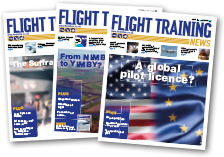The UK Civil Aviation Authority (CAA) is urging EU-licensed pilots, engineers and aviation businesses operating in the UK to gain dual UK licences as quickly as possible, fearing that some may leave it too late to make an end of year deadline. Currently, the UK CAA is permitting EU licensed pilots to operate UK-registered aircraft (meanwhile the EU has decided not to reciprocate by recognising UK licences). However, this permission runs-out at the end of the year and due to potentially long processing times – the CAA expects to be deluged with applications – leaving it until later in the year may prove too late.
Post-Brexit, the mutual recognition of pilot licences between the UK and EU has perhaps become the single most requested agreement sought by the UK aviation industry. Airlines, flight training schools, aviation associations, pilot unions and individual pilots, instructors and examiners have all been lobbying UK Government, asking for mutual licence recognition to be agreed with the EU, but it appears that any solution remains a long way off.
It is unlikely that more than a day goes by without Aviation Minister Robert Courts receiving a letter from someone in the UK aviation industry pleading for a resolution. The minister’s stock answer appears to be that UK Government is committed to working with the EU and its aviation agency, EASA, on future areas of cooperation, but that these types of negotiations take time, so don’t hold your breath.
The reality, of course, is that while the UK could enact such an agreement, unilaterally and at short notice, the EU cannot, instead first requiring the support of its 27 Member States. And, of course, this is where it gets political. No amount of entente cordiale can overcome the reality of the hostile atmosphere that exists between the EU and the UK post-Brexit. It is not difficult to believe that an element of schadenfreude is likely amongst the EU’s Member States with regards to the UK’s termination of its EU membership and the regulatory muddle which has followed.
Recognising that licensing chaos would likely ensue after Brexit, UK Government granted permission for the CAA to enact a two-year waiver for EASA-licensed pilots to continue to fly UK registered aircraft, ending this December. Unfortunately, the EU didn’t see fit to do the same. The current status quo therefore is that EU-licensed pilots can fly UK-registered aircraft, but UK-licensed pilots can’t fly EU planes. This unlevel playing field is due to end on 31 December 2022, when the CAA ends its current derogation, but the ‘levelling-up’ will actually amount to a ‘levelling-down’ as it seems that right now neither party will recognise the other party’s licensing system.
The new normal will then comprise a dual licensing regime for those pilots who require the ability to fly both UK and EU-registered aircraft. For pilots who gained their licences prior to Brexit the regulatory hoops will ultimately involve no more than additional paperwork (and additional fees), plus a potential new medical examination, depending on the status of their current one. But for new entrants to the aviation world, dual licences will require dual training programmes. A UK citizen with their eyes on an airline career will therefore need to decide whether to:
- opt to train for a UK commercial pilot licence, in order to be eligible to work for a UK airline;
- to train for an EU commercial pilot licence, in order to be eligible to work for an EU airline;
- to undertake the option of training for both licences.
What muddies the water further is that many UK airlines now have EU subsidiaries, established in the run-up to Brexit to give them the right to operate internally within the EU. Likewise, EU airlines operating domestic routes in the UK are required to operate UK-registered aircraft flown by UK-licensed pilots.
As reported previously, a number of UK flight training schools are now offering dual licensing programmes, whereby a cadet graduates with both UK and EU licences (and two medical certificates, possibly from the same Aeromedical Examiner if he/she holds dual approval). This means that cadets now have to sit two sets of ground exams and pass two CPL and two IR flight tests (IRT). The EASA IR flight test is a particular problem for UK schools as EU legislation dictates that it must be carried out in EU airspace. UK schools are therefore having to transit into EU airspace, either to France or Ireland, to conduct the tests, despite the fact that the UK continues to be a signatory to the Standardised European Rues of the Air (SERA). Other UK schools less conveniently located will need to send their cadets to a partner school in the EU. The additional cost burden when training for both licences is estimated to be around £5,000 at present. The additional work involved isn’t that burdensome at the moment, but there are fears that future divergence in training syllabi could lead to confusion when sitting ground exams. When the UK left the EU and ended its membership with EASA, it took with it EASA’s ATPL question bank from which ground exams are drawn. However, EASA has already revised the question bank a number of times since Brexit and so the two question banks are already marginally different. While the subject matter will fundamentally remain the same, it could be that divergence in key learning objectives in future could lead to cadets having to expand their ATPL theoretical knowledge base to cope with the differences between the two licensing regimes and that it could prove confusing, to say the least.
Commenting on the dual licensing regime now forced on UK flight schools, Simon Bailey, director of Euro Flight Training, a dual approved ATO at Lee-on-Solent, says: “The situation now faced by UK and EASA licensed pilots is the latest blow to an already struggling industry. Government needs to urgently and effectively find a solution to this catastrophic mess. The only way of reversing this in reality is for the UK to re-join EASA (now one of the largest aviation authorities in the world) or risk becoming totally irrelevant.”
David Hoy from the Independent Flight Examiners & Instructors Association (IFEIA) adds: “The present situation between the UK and EASA would make a sound basis for a television comedy were it not so tragic. Students are now taking two groups of written examinations, two CPLs and two IRTs. Imagine telling every university graduate that they must sit two sets of examinations. The cost of this, ultimately borne by the students, is enormous. There was no need to leave EASA. Brexit did not require it. The harm done to our industry through our departure has been enormous.”
Returning to current licensed pilots, the new deadline in their lives is 31 December 2022, the date when the CAA will end its two-year derogation period on recognition of EU licences. Ahead of Brexit a large proportion of UK commercial pilots undertook a State of Licence Issue (SOLI) change in order to be permitted to continue to fly EU-registered aircraft with EU carriers, such as Ryanair. These pilots moved their UK-issued licences and pilot medicals to an alternative EU Member State, the two most popular being Austria and Ireland. As of 01 April last year, the UK CAA opened a new application process for EASA licence holders to gain a UK licence off the back of their EASA one. This process will remain in place until 31 December 2022 and allows for a pilot to hold a UK licence at the same time as an EU one issued by an EASA Member State, without any requirement to undergo additional training or pass additional exams/ flight tests.
While there are still 11 months to go before the UK ends its current derogation period for EU-licensed pilots, the clock is certainly ticking in terms of how fast pilots need to react. When UK pilots started the SOLI process pre-Brexit, in order to get their UK-issued licences re-issued by EU Member States, there were a number of pilots who were caught out by a system that was clearly struggling to cope. There were multiple instances of licence conversions taking months rather than weeks to complete, leaving pilots effectively unlicensed and unable to work. The creaking bureaucratic machine may have been better oiled this time round but there remains a strong possibility that leaving the application process until later in the year might result in similar chaos and so the CAA are urging pilots to act now. Come January 2023 the application window will be locked shut and those who have failed to gain a duplicate UK licence will likely be required to follow the same conversion process as pilots holding other international ICAO-compliant licences, including undertaking all ground exams and completing a skills test.
Commenting on the importance of getting licence applications in as quickly as possible, the UK CAA’s Chief Executive, Richard Moriarty, said: “Whether you are a pilot or an engineer with a European licence and currently work with UK-registered aircraft, or think you might wish to in the future, now is the time to apply. Until 31 December 2022 the CAA has simplified the application process for gaining UK licences, and we expect demand to be high, so we advise everyone to apply as soon as possible. European organisations wanting to operate and maintain UK-registered aircraft also need to assess how they might be affected by the changes and refer to our website for dedicated information on how to gain UK licences.”
Aviation Minister Robert Courts echoed Richard Moriarty’s urgency, stating: “Together with the Civil Aviation Authority I urge businesses to ensure they are fully ready by applying early for UK certification and licences. After 31 December 2022 EU aviation safety certificates will no longer be accepted in the UK, and it’s imperative that our industry is aware of this upcoming change to ensure the future viability of the sector.”
CAA’s microsite detailing the processes required to convert licences.







